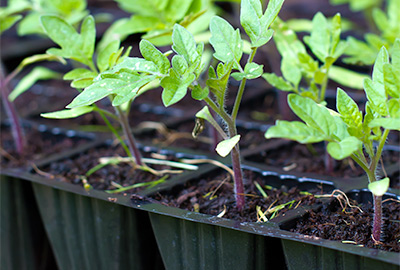Grow Tomato Transplants Indoors Starting Late Summer

See customized advice and information for growing tomatoes in your Southern California zipcode
Don’t know your GardenZeus California Climate Zone? Enter your zipcode at GardenZeus.com.
GardenZeus receives commissions for purchases made through links on this post.
Midsummer through late summer can be a challenging period for gardening in hot Southern California areas, with the proportion of chores tending to be high compared to the fun. Watering, managing pests and diseases. cleanup, removing expired plants, composting, and hopefully harvesting – not exactly the list of favorite tasks for most gardeners, especially when daytime temperatures are too high to be working comfortably outdoors after morning or before evening.
Starting tomato seeds indoors in late summer can satisfy the gardening itch when other planting options aren’t available, put the fun back into late-summer gardening, and put you on track for harvesting delicious homegrown outdoor tomatoes in mild-winter California areas by Thanksgiving or even late October if you grow early varieties.
Ideally tomato seedlings should be transplanted within about 4 to 8 weeks of germination, but they tolerate rootbinding better than most vegetables. With good growing conditions including sufficient light and sufficiently large pot size, the seedling period can be extended to at least 6 to 10 weeks if hot weather persists later into fall, and seedlings can be grown to a larger size indoors to be transplanted whenever cool-to-warm fall weather arrives. Unlike most vegetables, tomatoes that are rootbound but otherwise healthy are still likely to yield well if they receive proper care.
To start tomato seeds and grow transplants indoors, you will need sufficient space in a well-lit, warm indoor area. If using grow lights, you will need overheat clearance to avoid burning plants with the lights. This varies by plant and light, with 18 inches to 3 feet clearance above plants usually sufficient for small-to-medium grow lights. Several hours or more light per day is ideal. GardenZeus recommends this power-efficient, inexpensive, small grow light for seedlings or small plants; and this better-quality, stronger grow light for both seedlings and plants.
Temperatures of 65° to 85°F are best for germinating tomato seeds, with an ideal temperature of 85°F. I have found this indoor thermometer to be reliable and helpful for managing plants indoors. Seeds germinate best with a source of bottom heat, such as this seedling heat mat. I find it easiest to grow indoors in an area with a water source nearby. This handy adapter will allow you to connect many household faucets directly to a short garden hose. If growing seedlings on a counter near a sink, this short sink hose may be indispensable. If ants are a problem in your home, set up a water moat or barrier around pots or growing trays to keep them out.
Select your tomato varieties with care. Choose short-season and cold-tolerant tomato varieties for growing from late-summer or fall through spring. Oregon Spring is a parthenocarpic variety that does not require pollination to set fruit, so is suited to growing during both hot summers and cool winters in California. Siberian, Siletz, and Stupice set fruit at colder temperatures. See Growing Winter Tomatoes in Mild California Areas for more information.
If space allows, the simplest method for growing larger tomato transplants indoors is to germinate several seeds in each 6-inch-or-larger pot, and thin progressively over the next few weeks to the single strongest seedling. Another option is to germinate seeds in a glass dish or bowl, or in small cells or pots, and transplant seedlings into larger pots. See The GardenZeus Guide to Starting Tomato Seeds for tips, tricks, and information for germinating tomato seeds indoors.
After the first few weeks, seedlings may need support or training to grow upright. Under conditions of insufficient light, seedlings become leggy, weak, spindly, and prone to disease. Leggy seedlings may still fruit productively if provided good care after transplanting. Tomatoes produce roots internodally on stems, so a leggy seedling can be planted more deeply than the root crown with buried stem(s) becoming part of the root system.
Harden off all indoor-grown tomato seedlings for about 7 to 14 days (depending upon the harshness of your outdoor conditions, with longer periods during hot and cold weather) before transplanting or exposing to full sunlight all day. Expose seedlings to direct sunlight and outdoor conditions for 30 to 60 minutes on the first day, then increase this time progressively for about 30 to 45 minutes per day for about 10 to 14 days before transplanting outdoors. Start hardening off tomato seedlings anytime after they’re about 3-to-4-weeks old and at least two weeks before you might want to transplant them outdoors so you’re ready when a period of cooler weather finally arrives.
When should you transplant your indoor-grown tomato seedings? After seedlings are hardened off, and if you are prepared to pay careful attention to the seedlings (such as providing shade and extra water during inevitable late heatwaves), transplant seedlings outdoors at the beginning of the first period in September or October when temperatures are forecast to be in the 80s to low 90s or cooler for at least a week. If you can’t provide close attention to seedlings, it’s best to wait to transplant until temperatures are are consistently cool-to-warm, usually by mid-October to mid-November.
See customized advice and information for growing tomatoes in your Southern California zipcode
Tomato and Tobacco Hornworms in the California Home Garden
Yellow Leaves on Tomato Plants: A GardenZeus Guide, Part 1 of 3 (Management and Maintenance Issues)
Yellow Leaves on Tomato Plants: A GardenZeus Guide, Part 3 of 3 (Pests and Diseases)
GardenZeus Tips for Fertilizing Tomatoes During the Growing Season
The GardenZeus Guide to Staking, Supporting and Trellising Tomato Plants
GardenZeus Solutions to Common Abiotic Problems With Garden Tomatoes


